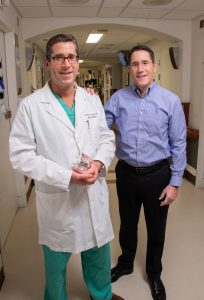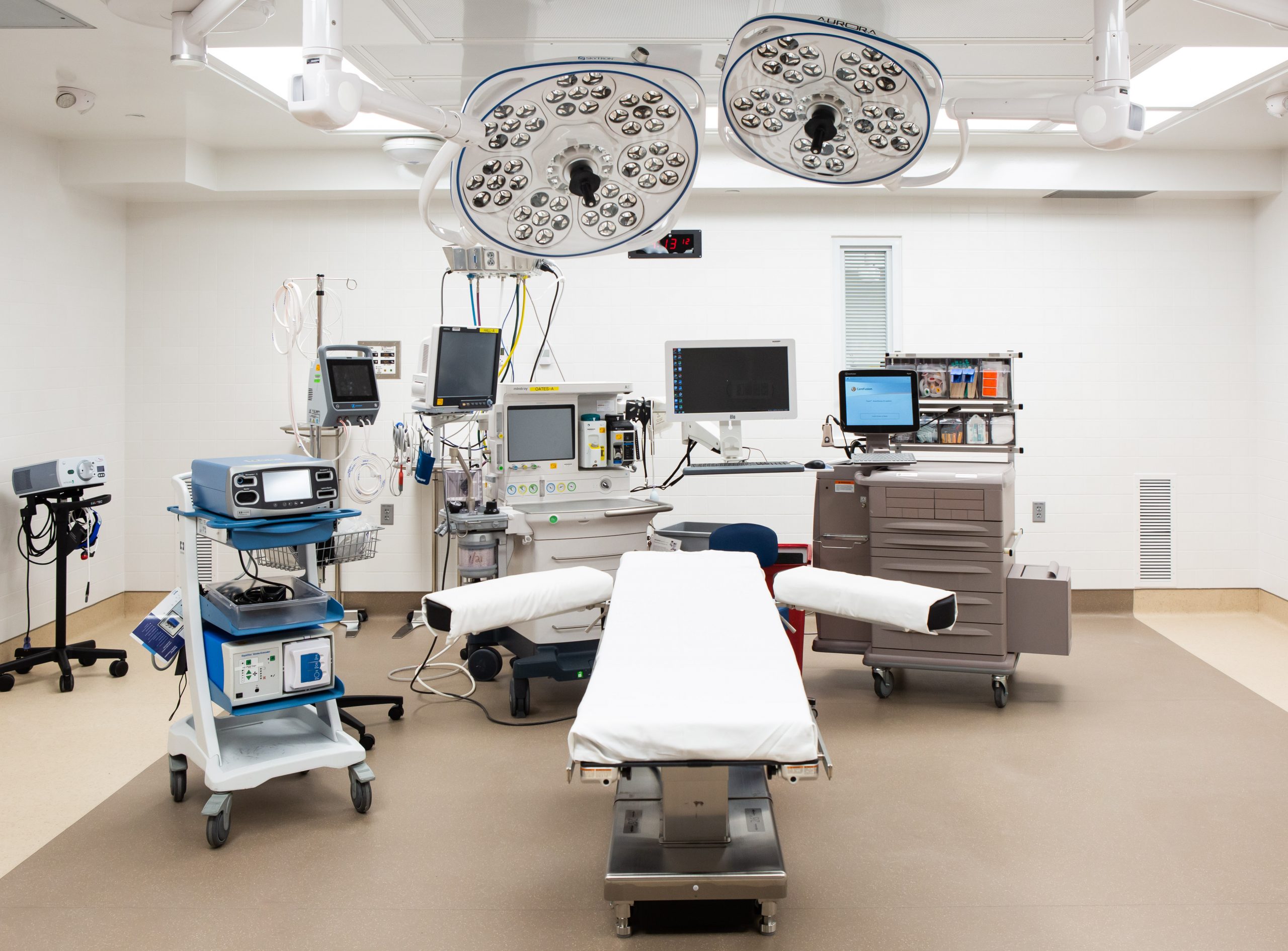Thanks to the newest member of Middlesex Health’s orthopedic team – a robot – surgeons can do minimally invasive spine surgery more precisely, and thus more safely, than ever before.
Last summer, spine surgeons at Middlesex started using the Globus ExcelsiusGPS, a cutting-edge robotic system that guides surgeons in the placement of screws and implants during spinal fusion.
Robots have been available for use during spine surgery for more than a decade, says spine surgeon Jeffrey A. Bash, MD. But surgeons at Middlesex saw few advantages to using them – until now – as early spine robots were not as technologically sophisticated.
“Our department has been at the forefront of adopting newer technologies in spine surgery, especially technologies that allow us to take less invasive approaches to the treatment of spine issues like scoliosis, herniated discs, spinal stenosis and pinched nerves,” says Dr. Bash. “But this is by far the most advanced robotic system available for spinal surgery.”
Not only does use of the Globus ExcelsiusGPS reduce the risk of complications during fusion, he says, but procedures done with the robot typically require smaller incisions and produce less bleeding.
Demand for spinal fusion on the rise
 Spinal fusion, a welding-like procedure in which two segments of the vertebrae in the back are fused together to restore stability and reduce painful movement between bones, is an increasingly common procedure. According to a report by The Dartmouth Institute for Health Policy and Clinical Practice, spinal fusion operations among Medicare recipients aged 65 and above increased 67 percent between 2001 and 2011.
Spinal fusion, a welding-like procedure in which two segments of the vertebrae in the back are fused together to restore stability and reduce painful movement between bones, is an increasingly common procedure. According to a report by The Dartmouth Institute for Health Policy and Clinical Practice, spinal fusion operations among Medicare recipients aged 65 and above increased 67 percent between 2001 and 2011.
Dr. Bash says that the demand for spine surgery continues to rise, in part because baby boomers are getting older – and many of the conditions that cause back issues develop with age – but also, ironically, because people are trying to stay fit as they age. “We have a lot of patients who are wounded weekend warriors,” he says.
In addition to treating fractures of the spine, fusion can be used to treat back pain stemming from conditions including spinal stenosis (a narrowing of the spinal canal that causes compression of the spinal cord and/or nerve roots), bone spurs (or growths) in the spine, scoliosis (curvature of the spine), spondylolisthesis (shifting of a disk) or degenerative disk disease (narrowing of the space between disks).
“Our goal is to make patients better and more functional without surgery, using physical therapy, chiropractic care, and epidural-type injections,” says Dr. Bash. “But when non-operative care is unable to help these patients, surgery is the next step.”
What makes the new robotic technology so revolutionary, Dr. Bash says, is that it “allows you to see, in real time, exactly where the screw is going into the spine.”
With conventional spinal fusion, the surgeon has to keep moving the X-ray machine into different positions to determine where to place the screw. The new technology allows the surgeon to input a CT scan of the patient’s spine, marked with where he or she wants to place the hardware, into a computer pre-operatively.
“When you go to the operating room, the data gets sent from the computer to the robot, which can direct us exactly where to put the screw to ensure greater accuracy,” he explains.
Another plus, says Dr. Bash, is that exposure to radiation is drastically reduced, since the robotic guidance decreases the need for prolonged use of fluoroscopy (an X-ray “movie,” in effect, produced when a continuous X-ray beam is passed through the body). Despite its benefits, Dr. Bash adds, the robot “is not like a self-driving car.” Like a GPS, he says, the robot provides guidance, but is just another tool in the surgeon’s armamentarium – one that still requires significant experience to be used effectively.
“The four spinal surgeons in our department have placed well over 100,000 screws in our careers, with great accuracy,” he says. “This [new technology] allows us to place them with even greater accuracy, in a quicker time frame.”
Other advances in orthopedics
Other recent advances in spine surgery, says Dr. Bash, include improvements in implants and devices for use in conjunction with fusion and for less invasive surgeries; in fact, Dr. Bash and his colleagues at Middlesex hold more than 25 patents for different surgical devices. These include cages to replace fractured vertebrae, spinal retractors that allow smaller incisions with greater visibility, and spinal fusion cages, which are used to replaced damaged disks. Sometimes the disks, which act as shock absorbers between the vertebrae, degenerate and require replacement, Dr. Bash explains. “The cages are used as placeholders between vertebrae.”
The latest orthopedic advances do not just benefit spine patients, says Terry Reardon, MD, an orthopedic surgeon at Middlesex Health. Design changes and improvement in quality and materials have produced knee and hip implants that can last a person’s lifetime, he says, even if patients are relatively young when undergoing replacement surgery.
“One of the implants we use is FDA-approved to be marketed as a 30-year knee replacement,” he says.
Many of today’s implants are made of titanium, a durable, long-lasting material that does not interfere with CT scans or MRIs.
Like the spine surgeons, knee specialists at Middlesex are also able to achieve more precise placement of knee implants using robotic technology.
According to Dr. Reardon, the Navio robotic system, which orthopedists have been using during knee replacement surgery for the past year, relies on sensors and topographic maps of the knee joints to facilitate implant placement.
“Unlike Dr. Bash’s robot, which is a live guidance unit, ours is based on topography,” says Dr. Reardon. “We map out the topographic area of the joint we are replacing, and the map is stored in the memory of the computer. The robot can subtract the bone we have to remove and helps us to place the implants in a more precise way.”
By viewing the map of the patient’s joint on the computer screen, surgeons can ensure that the implant is exactly where they want it to be; the robot communicates with sensors in the handheld instruments as well as in drill pegs attached to the bone, and pulls back the drill’s burr when the surgeon has removed enough bone for proper implant placement.
According to Dr. Reardon, because people are living longer and staying more active, the demand for knee replacements is also growing every year.
Middlesex orthopedists perform outpatient procedures that don’t require robotic assistance at both the Middlesex Center for Advanced Orthopedic Surgery, an orthopedic-only outpatient surgery center, and at Middlesex Hospital. But in February, the hospital opened a new orthopedic surgical suite containing two spacious operating rooms and designed to accommodate new technologies such as robotics.
According to Dr. Bash, “the future of the robot will be even more exciting.” The Globus ExcelsiusGPS, he says, is designed to support additional advances in minimally-invasive spine surgery, like decompression procedures, which alleviate pressure on the spinal cord.
Meanwhile, according to Drs. Bash and Reardon, state-of-the art blood sparing techniques reduce the bleeding associated with joint replacement, and recent improvements in anesthesia, including longer-lasting local anesthetics, make it much less painful for patients after orthopedic surgery.
“We’re very proud to be able to deliver these services to patients,” says Dr. Bash. “Because at the end of the day, to see a patient who was completely debilitated come back to see you in the office pain-free is extremely rewarding.”
Lori Miller Kase is a freelance writer living in Simsbury.









More Stories
Jamie Shawver, D.O.: The Modern-Day Family Doctor
Leading in Urologic Oncology: Ryan Dorin, M.D., Works on Expanding Patient Care
UConn Health Stands at the Forefront of Comprehensive Sickle Cell Treatment in the U.S.